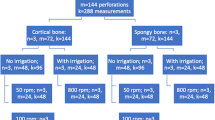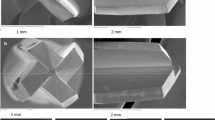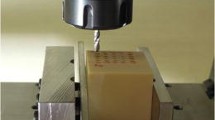Abstract
Introduction
During the drilling of the bone, the temperature could increase above 47°C and cause irreversible osteonecrosis. The result is weakened contact of implants with bone and possible loss of rigid fixation. The aim of this study was to find an optimal condition where the increase in bone temperature during bone drilling process would be minimal.
Materials and methods
Influence of different drill parameters was evaluated on the increase of bone temperature. Drill diameters were 2.5, 3.2 and 4.5 mm; drill speed 188, 462, 1,140 and 1,820 rpm; feed-rate 24, 56, 84 and 196 mm/min; drill point angle 80°, 100° and 120° and external irrigation with water of 26°C.
Results
Combinations of drill speed and drill diameter with the use of external irrigation produced temperatures far below critical. Without external irrigation, temperature values for the same combination of parameters ranged 31.4–55.5°C. Temperatures above critical were recorded using 4.5 mm drill with higher drill speeds (1,140 and 1,820 rpm). There was no statistical significance of different drill point angles on the increase or decrease of bone temperature. The higher the feed-rate the lower the increase of bone temperature.
Conclusions
The external irrigation is the most important cooling factor. With all combinations of parameters used, external irrigation maintained the bone temperature below 47°C. The increase in drill diameter and drill speed caused increase in bone temperature. The changes in drill point angle did not show significant influence in the increase of the bone temperature. With the increase in feed-rate, increase in bone temperature is lower.



Similar content being viewed by others
References
Bolhofner BR, Russo PR, Carmen B (1999) Results of intertrochanteric femur fractures treated with a 135° sliding screw with a two-hole side plate. J Orthop Trauma 13:5–8
Lunsjo K, Ceder L, Thorngren KG et al (2001) Extramedullary fixation of 569 unstable intertrochanteric fractures: a randomized multicenter trial of the Medoff sliding plate versus three other screw-plate systems. Acta Orthop Scand 72:133–140
Mullaji AB, Thomas TL (1993) Low-energy subtrochanteric fractures in elderly patients: results of fixation with the sliding screw plate. J Trauma 34:56–61
Wachtl SW, Gautier E, Jakob RP (2001) Low reoperation rate with the Medoff sliding plate: 1 technical failure in 63 trochanteric hip fractures. Acta Orthop Scand 72:141–145
Feith R (1975) Side effects of acrylic cement, implanted into bone. Acta Orthop Scand 161(Suppl):3–136
Huiskes R (1980) Some fundamental aspects of human joint replacement. Acta Orthop Scand 185(Suppl):1–208
Eriksson RA, Albrektsson T, Magnusson B (1984) Assessment of bone viability after heat trauma. A histological, histochemical and vital microscopic study in the rabbit. Scand J Plast Reconstr Surg 18:261–268
Abouzgia MB, James DF (1995) Measurements of shaft speed while drilling through bone. J Maxillofac Surg 53:1308–1315
Bachus KN, Rondina MT, Hutchinson DT (2000) The effects of drilling force on cortical temperatures and their duration: an in vitro study. Med Eng Phys 22:685–691
Benington IC, Biagioni PA, Crossey PJ et al (1996) Temperature changes in bovine mandibular bone during implant site preparation: an assessment using infra-red thermography. J Dent 24:263–267
Aerssens J, Boonen S, Lowet G, Dequeker J (1998) Interspecies differences in bone composition, density, and quality: potential aplications for in vivo bone research. Endocrinology 139:663–670
Sedlin ED, Hirsch C (1966) Factors affecting the determination of the physical properties of femoral cortical bone. Acta Orthop Scand 37:29–48
Matthews LS, Hirsch C (1972) Temperature measured in human cortical bone when drilling. J Bone Joint Surg 54A:297–308
Natali C, Ingle P, Dowell J (1996) Orthopaedic bone drills––can they be improved? Temperature changes near the drilling face. J Bone Joint Surg Br 78:357–362
Jacob CH, Berry JT, Pope MH (1976) A study of the bone machining process-drilling. J Biomech 9:343–349
Lentrodt J, Bull HG (1976) Animal experimental studies on bone regeneration following drilling of the bone. Dtsch Zahnarztl Z 31:115–124
Rhinelander FW (1974) Tibial blood supply in relation to fracture healing. Clin Orthop Relat Res 105:34–81
Berman AT, Reid JS, Yanicko DR et al (1984) Thermally induced bone necrosis in rabbits: relation to implant failure in humans. Clin Orthop 186:284–292
Bonfield W, Li CH (1968) The temperature dependence of the deformation of bone. J Biomech 1:323–329
Lundskog J (1972) Heat and bone tissue. An experimental investigation of the thermal properties of bone and threshold levels for thermal injury Scand. J Plast Reconstr Surg 9:1–80
Eriksson AR, Albrektsson T (1983) Temperature threshold levels for heat-induced bone tissue injury: a vital-microscopic study in the rabbit. J Prosthet Dent 50:101–107
Neal JG, Cox MJ, Drake DB et al (1997) A new computerized control unit for small bone surgical instruments. Med Prog Technol 21(Suppl):25–29
Bechtol CO, Ferguson AB, Laing PC (1959) Metals and engineering in bone and joint surgery. Williams & Wilkins, Baltimore
Farnworth GH, Burton JA (1974) Optimization of drill geometry for orthopaedic surgery. In: 14th International machine tool design and research conference. Manchester, England
Bast P, Engelhardt M, Lauer W et al (2003) Identification of milling parameters for manual cutting of bicortical bone structures. Comput Aided Surg 8:257–263
Costich ER, Youngblood PJ, Walden JM (1964) Operative oral surgery. A study of the effects of high-speed rotary instruments on bone repair in dogs. Oral Surg Oral Med Oral Pathol Oral Radiol Endod 17:563–571
Moss RW (1964) Histopathologic reaction of bone to surgical cutting. Oral Surg Oral Med Oral Pathol Oral Radiol Endod 17:405–414
Lavelle C, Wedgwood D (1980) Effect of internal irrigation on frictional heat generated from bone drilling. J Oral Surg 38:499–503
Benington IC, Biagioni PA, Briggs J et al (2002) Thermal changes observed at implant sites during internal and external irrigation. Clin Oral Implants Res 13:293–297
Matthews LS, Green CA, Goldstein SA (1984) The thermal effects of skeletal fixation-pin insertion in bone. J Bone Joint Surg Am 66:1077–1083
Saha S, Pal S, Albright JA (1982) Surgical drilling: design and performance of an improved drill. J Biomech Eng 104:245–252
Sorenson FM, Cantwell KR, Alpin AW (1964) Thermogenics in cavity preparation using air turbine handpieces: the relationship of heat transferred to rate of tooth structure removal. J Prosthet Dent 14:3–9
Davidson SR, James DF (2003) Drilling in bone: modeling heat generation and temperature distribution. Biomech Eng 125:305–314
Wiggins KL, Malkin S (1976) Drilling of bone. J Biomech 9:553–559
Toews AR, Bailey JV, Townsend HG, Barber SM (1999) Effect of feed rate and drill speed on temperatures in equine cortical bone. Am J Vet Res 60:942–944
Sundén G (1967) Some aspects of longitudinal bone growth: an experimental study of the rabbit tibia. Acta Orthop Scand 103(Suppl)
Acknowledgments
This experiment is a part of the scientific project: Biomechanics of fractures and fracture healing and is supported by The Ministry of Science, Education and Sports.
Author information
Authors and Affiliations
Corresponding author
Rights and permissions
About this article
Cite this article
Augustin, G., Davila, S., Mihoci, K. et al. Thermal osteonecrosis and bone drilling parameters revisited. Arch Orthop Trauma Surg 128, 71–77 (2008). https://doi.org/10.1007/s00402-007-0427-3
Received:
Published:
Issue Date:
DOI: https://doi.org/10.1007/s00402-007-0427-3




